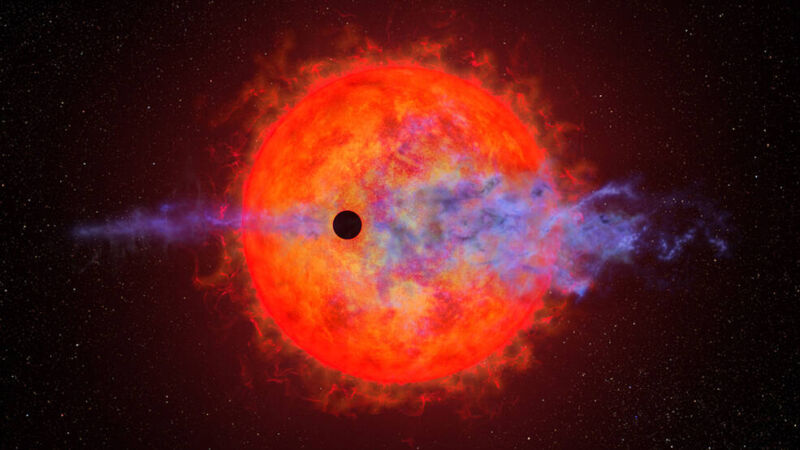

Some planets cannot hold on to their atmospheres. It’s thought that most of whatever atmosphere Mars may have had was annihilated by the solar wind billions of years ago, even as Earth and Venus held on to theirs. But there are planets that orbit so close to their star that atmospheric loss is inevitable. With at least one of them, we’ve learned that it is also unpredictable.
Exoplanet Au Mic b is that planet. It orbits the young, hot, and temperamental red dwarf star Au Microscopii (Au Mic), which is only 23 million years old—nothing compared to our 4-billion-year-old sun. NASA’s Hubble Space Telescope caught this scorched world losing a portion of its atmosphere.
When a team of scientists from the NASA Goddard Space Flight Center, Dartmouth College, the University of California at Santa Cruz, and other institutions analyzed the Hubble observations, they were confused by the planet’s erratic behavior. There would be evidence of atmospheric loss in some of the data, then suddenly none at all. It was unpredictable.
What causes this planet to have its atmosphere vaporized some of the time—and then seemingly escape that fate for a while? Further analysis revealed that it was unlikely that Au Mic B escaped the wrath of its star. The team realized that there were instances when the ruthless destruction of its atmosphere was just not visible, and there are possible explanations as to why.
Taking the heat
Hot young stars frequently experience a phenomenon known as magnetic reconnection, where magnetic field lines break and then connect again, releasing gobs of searing hot plasma into space. While the sun has its tantrums, the flares and coronal mass ejections caused by magnetic reconnection are stronger in younger, hotter stars like Au Mic. What makes Au Mic b especially vulnerable to being hit by a plasma eruption is that it orbits an uncomfortably close 9.7 million kilometers (about 6 million miles) from its star. Mercury, the closest planet to the sun in our Solar System, orbits ten times further away and still barely has any semblance of an atmosphere.
Au Mic b makes Mercury look almost hospitable. It’s around the size of Neptune and lives fast, zooming around its star in just eight days while getting constantly blasted by stellar winds and UV radiation. Planets born within the first 100 million years of their star’s life are more likely to lose the most material from their atmospheres (depending on when and how far away they formed), and this one is no exception. Flares heat their hydrogen atmosphere to the point that the gas is no longer held by the planet’s gravity and is released into space.
Now you see me…
Hubble observed Au Mic b during two of its transits, when it passed in front of its star and caused a dip in starlight. These observations were done at a wavelength that can allow us to watch hydrogen leaving the planet. Oddly, the loss of hydrogen was only apparent some of the time.
“While no planetary absorption could be definitively identified in [transit] 1, [transit] 2 indicates that planetary neutral hydrogen is escaping ahead of AU Mic b and being accelerated away from the host star,” they said in a study recently published in The Astronomical Journal.
The atmospheric gas outflows are possibly shaped by stellar winds from Au Mic, which don’t allow all of the escaped gas to trail behind Au Mic b. These winds are so powerful that they actually push some of that gas in front of the planet. It’s possible that this wind could have shaped the tail in such a way to make it unobservable from Hubble’s perspective.
Something else that might be to blame for not all of Au Mic b’s outflows being observable is photoionization. Au Mic had just burst out in an enormous stellar flare hours before the first transit. This flare was so energetic that it could heat the gas particles and ionize them to the point that they became invisible when viewed at the wavelengths that Hubble was observing them in. The flare’s aftermath is thought to have lasted throughout the first transit, so the ionization was likely still going on as Hubble watched.
Much is still unknown about planets like Au Mic b. Do hot Neptunes, Jupiters, and Saturns that have their atmospheres devoured then turn into super-Earths when their cores are exposed? For now, Hubble will keep its eye on this bizarre planet.
The Astronomical Journal, 2023. DOI: 10.3847/1538-3881/ace536

